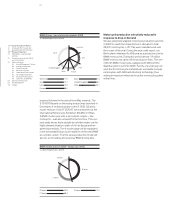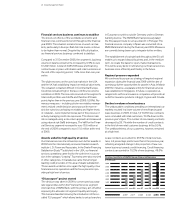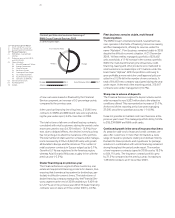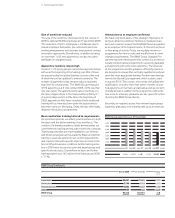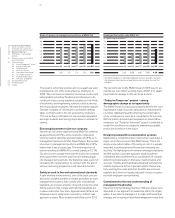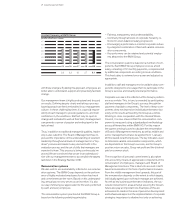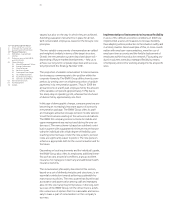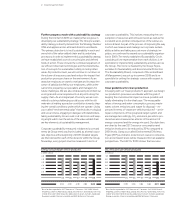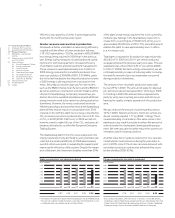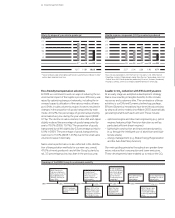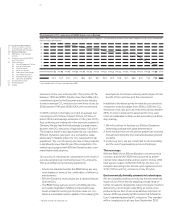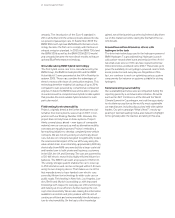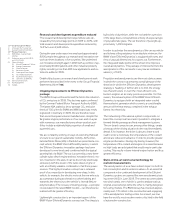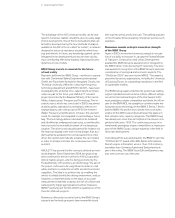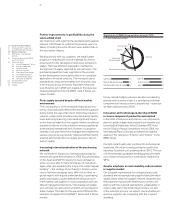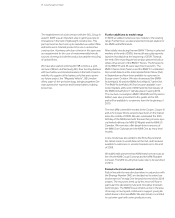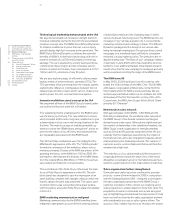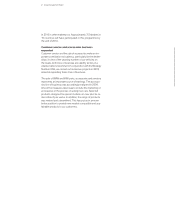BMW 2009 Annual Report Download - page 36
Download and view the complete annual report
Please find page 36 of the 2009 BMW annual report below. You can navigate through the pages in the report by either clicking on the pages listed below, or by using the keyword search tool below to find specific information within the annual report.
34
12 Group Management Report
12 A Review of the Financial Year
14 General Economic Environment
18 Review of Operations
42
BMW Group – Capital Market
Activities
45 Disclosures pursuant to § 289 (4)
and § 315 (4) HGB
48 Financial Analysis
48 Internal Management System
50 Earnings Performance
52 Financial Position
54 Net Assets Position
56 Subsequent Events Report
56 Value Added Statement
58 Key Performance Figures
59 Comments on BMW AG
63 Internal Control System
64 Risk Management
70 Outlook
emissions of new cars in Europe (EU-15) by almost 27 %
between 1995 and 2008, thereby more than fulfilling the
commitment given by the European automotive industry
to reduce average CO2 emissions for new fleets of cars by
25 % between 1995 and 2008 (ACEA self-commitment).
In 2009 our fleet in Germany recorded an average fuel
consumption of 5.9 litres of diesel / 100 km, 6.5 litres of
petrol / 100 km and average emissions of 156 g / km of CO2,
thus confirming our leading role in the premium segment in
Germany. We also lead the field amongst European manu-
facturers
with CO2 emissions of approximately 150 g / km*.
The progress made is also appreciated by our customers.
Efficient Dynamics has given us a competitive edge,
particularly in markets subject to CO
2
-based vehicle tax
regulations. The cost of running our cars in these markets
is significantly lower than those of the competition. Pre-
owned cars equipped with Efficient Dynamics also com-
mand
higher residual prices.
Our success in reducing fuel consumption is the result of
our wide-ranging goal of achieving lower CO2 emissions.
This goal embraces the following statements:
– All vehicles manufactured by the BMW Group are
seg-
ment leaders in terms of the combination of efficiency
and dynamics.
– Efficient Dynamics technologies are a standard feature
of all vehicles.
– The BMW Group pursues a policy of fulfilling all emis-
sion-
related legislation. Making compensation
pay-
ments instead of investing in the future
does not con-
stitute a sustainable option capable of
encouraging the
development of emission-reducing
technologies for the
benefit of the customer and the
environment.
In addition to the above points we have also set ourselves
a long-term reduction target: from 2008 to 2020 the CO2
emissions of our cars are to be reduced by at least another
25 %. In order to achieve this target and to move even
closer to sustainable mobility, we are proceeding in a three-
step strategy:
1.
We will continue to develop our Efficient Dynamics
technology package with great determination.
2. In the medium term we will achieve greater fuel economy
through electrifying the drive train and developing hybrid
solutions.
3.
In the long term, we are committed to electromobility
and the use of regeneratively produced hydrogen.
The next steps
With the BMW Vision EfficientDynamics we presented a
concept car at the IAA 2009 that is powered by a three-
cylinder turbo diesel engine and two electric motors. With
total system output of 262 kW / 356 hp, the fuel con-
sumption
according to
the EU test cycle registered a mere
3.76 l / 100 km and CO
2
emissions of only 99 g / km.
Environmentally friendly automotive technologies
We are constantly working on reducing the environmental
impact of our vehicle fleet by adopting a broad range of
further innovations designed to reduce the levels of carbon
dioxide (CO2) and nitrogen oxide (NOx) as well as noise
produced by our fleet of cars to an absolute minimum. In
autumn 2009 we already had 90 models that fulfilled the
Euro-5 standard governing NO
x
emissions. This standard
will be compulsory for all cars from September 2010
Development of CO2 emissions of BMW Group cars in Europe
(Index: 1995 = 100; Basis: fleet consumption of newly registered cars in Europe (EU-15) measured on the basis of the New European Driving Cycle in accordance
with the ACEA commitment)
105
100
95
90
85
80
75
70
95 96 97 98 99 00 01 02 03 04 05 06 07 08 09
*
100.0 101.0 102.4 101.0 98.6 96.7 96.7 92.9 92.9 94.8 90.0 88.6 80.0 73.3 71.4
*
measured only on EU-27 basis with effect from 2009
* 150 g / km internal calculation (EU-27)


